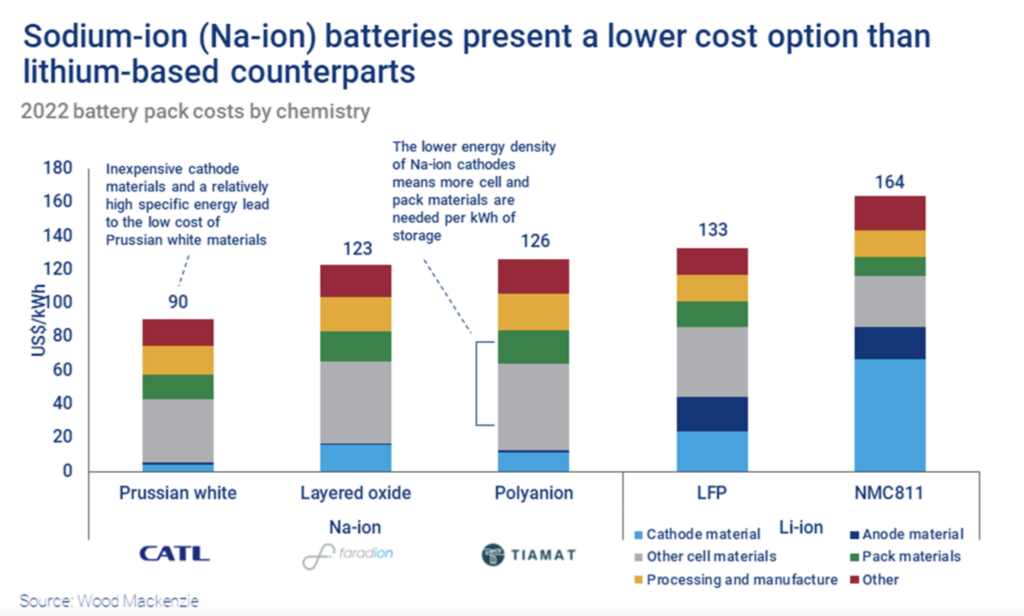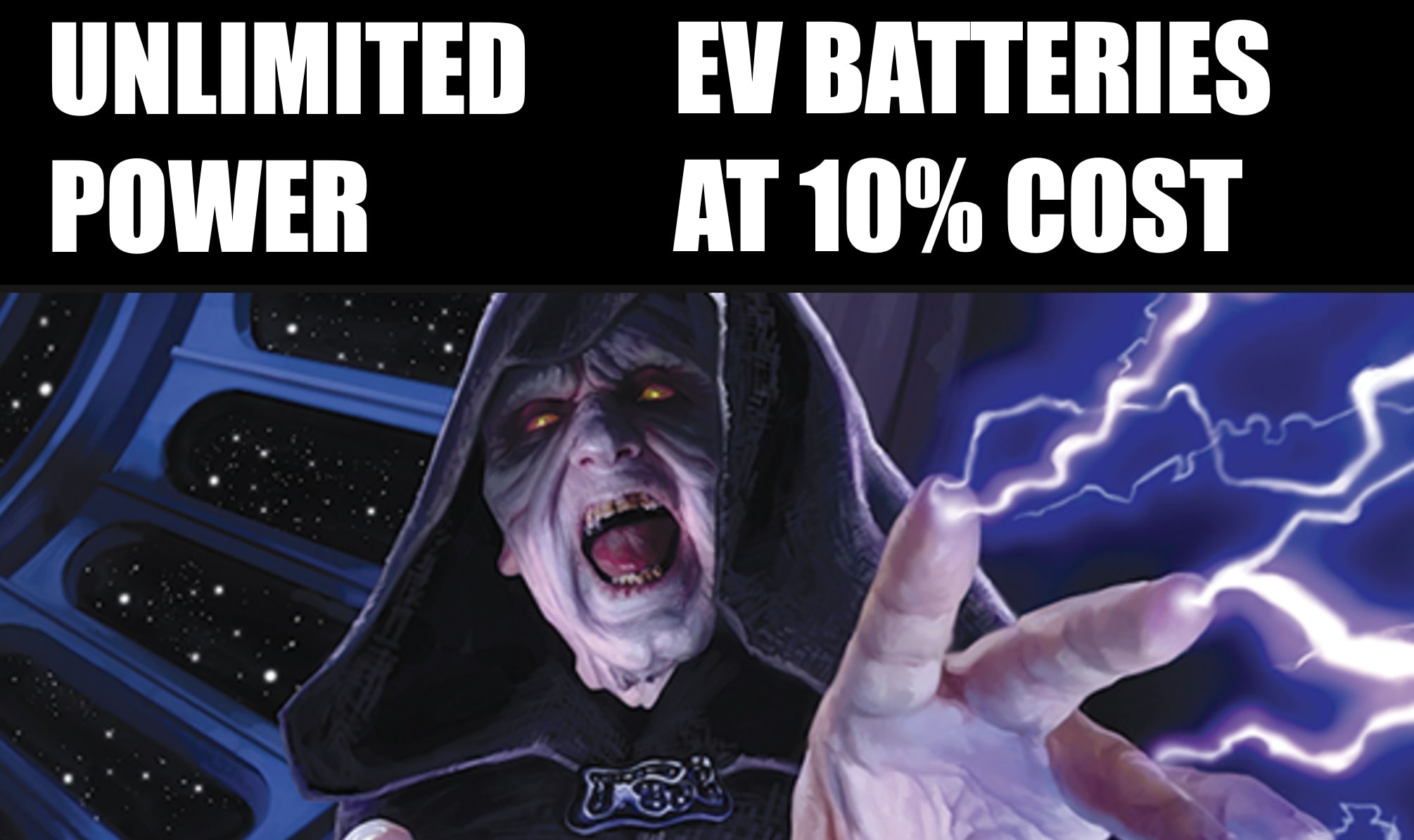CATL of China is mass producing generation one sodium ion batteries starting next month. The first factory has about a 40 GWH per year capacity.
China has 16 out of 20 globally planned or built sodium battery factories according to Benchmark Minerals.
CATL’s first-generation sodium battery generates 160-watt-hours per kilogram. This is 10% less energy than iron LFP batteries and 40% less than mass produced nickel batteries. CATL plans to increase the energy density of next generation sodium ion to 200 Wh/kg. CATL’s sodium-ion batteries will be used by China’s Chery, the first automaker to use the technology.
Nextbigfuture now has a video discussing the potential of sodium ion batteries. Brian Wang spoke with Randy Kirk on the topic of sodium ion.
The first generation sodium ion are a bit cheaper than LFP but the volumes will not be worldchanging. However, the second generation sodium ion could reach $40 per kWh. Iron LFP batteries could get to $50/kWh with really high volume and efficiency at the cell level. The future low price of sodium ion would make for insanely cheap fixed storage products like the Tesla Megapack and Powerwalls.
They also do not have practical material limits. There is no shortage of salt or soda ash. The United States has about 90% of the world’s readily mined reserves of soda ash. Wyoming has 47 billion tons of mineable soda ash in the Green River basin. There would be hundreds of TWH of power storage from each billion tons of soda ash.
Based on material costs of $4 per kWh there could be $8 to $10 per kWh sodium ion batteries in the future. This would be ten times cheaper than energy storage batteries today.




Soda Ash Mine in Wyoming
A new mine project near Green River will tap into the world’s largest soda ash deposit and satisfy the growing demand for electric vehicles and solar panels.

In 2019, annual demand for soda ash was about 58 million tons and by 2021, that jumped to 63 million tons.
The Wyoming mine, which the company is calling Project West, has the potential to produce 3 million tons to start and is scalable, so the company can increase production later. To facilitate soda ash exports, the company received a permit to export 14 million tons from a Stockton, California, port terminal. The mining will be done with an in-situ process to extract soda ash from trona ore. The ore is then processed into soda ash.
Water is injected as a brine or salt and water solution. It is then circulated throughout the mine workings to dissolve soda ash and salt from the original pillars and walls. The brine is pumped to an evaporation pond. Submersible pumps are used, each pumping about 9,000 liters per minute. As the liquid cools, the soda ash and salt crystals settle to the bottom of the pond. The cool brine is then heated and reinjected into the mine to start dissolving soda ash again. The remaining soda ash in the ponds is removed with floating dredges and pumped to the mill.
They will capture and recycle the water.

Brian Wang is a Futurist Thought Leader and a popular Science blogger with 1 million readers per month. His blog Nextbigfuture.com is ranked #1 Science News Blog. It covers many disruptive technology and trends including Space, Robotics, Artificial Intelligence, Medicine, Anti-aging Biotechnology, and Nanotechnology.
Known for identifying cutting edge technologies, he is currently a Co-Founder of a startup and fundraiser for high potential early-stage companies. He is the Head of Research for Allocations for deep technology investments and an Angel Investor at Space Angels.
A frequent speaker at corporations, he has been a TEDx speaker, a Singularity University speaker and guest at numerous interviews for radio and podcasts. He is open to public speaking and advising engagements.


The price of lithium batteries is still high, but it’ll stop once the demand drops and lithium prices drop a bit. This will only happen with cheap sodium batteries taking up the growth.
I’d buy a big sodium battery and solar panels to keep it topping itself up every day, for sure. At my unit, that would literally mean I could disconnect the grid!
The Gen 2 Sodium pack with 60kw/hr for less than $3000 implies a home power pack twice the size of current Tesla models (30 kw/hr) for less than $5000 that would be very suited to virtual power plant use. They’d pay for themselves in a few years
For vehicles energy per kg or liter is the most important factor & lithium beats anything else for batteries.
For stationary applications energy storage per $ in the most important factor. The article states that sodium ion batteries beat lithium, but do they beat all the other existing or possible energy storage means on energy/$ ?
Eg: pumped hydro was the only practical grid storage for decades. Does it still beat batteries given a good site? Would sodium ion batteries beat the liquid metal batteries from this company?
https://ambri.com/
I’d like to see someone develop pumped hydro based battery where they dig a cavern 100 ft under your house. Drilling/digging tech has improved dramatically recently… mark my words… that will be a very cheap energy storage option very soon.
You’re probably thinking of Gravity Power by Launchpoint. They would benefit from having a Boring Company TBM that could turn around and surface again, so a U shaped shaft.
After using the electrical energy in a battery, you can recharge it thousands of times. When you burn the gas, it is gone. You must physically transport more gas to get it in the tank. Not so for EVs. To convert gas to movement of a car is inefficient compared to turning electrical energy into movement.
Soda ash is sodium carbonate. Unless the carbon goes somewhere more useful, the obvious byproducts will be CO and CO2.
Roughly equal weights of sodium and CO2 from the soda ash.
For a lithium-ion battery, 7% of its weight is lithium, so let’s assume the same for sodium-ion. If we get 200 watt-hours per kg of battery, then we get 2.8 kWh per kg of sodium. For a 66 kWh battery that’s 23 kg of sodium, and also about 23 kg of CO2.
Not 23 tons, just 23 kilograms of CO2, released to produce the sodium for one electric car. Burning one gallon of gasoline produces 9 kg of CO2. If you get 30 mpg, then the CO2 from producing one car’s worth of sodium is equivalent to driving the gasoline car less than a hundred miles. The electric car will probably last several hundred thousand miles, and then you might even recycle the battery.
Gasoline is 12700 Wh/kg. This battery is 160 Wh/kg. So 79 times as much energy per mass.
Gasoline needs to have an engine and gas tank and other parts to make the vehicle do anything.
The Tesla Model Y weighs between 3,920 and 4,416 pounds. The 2023 Toyota RAV4 CRUISER (AWD) HYBRID weighs 3,869.1 lbs.
The Tesla Model Y comes in a few variations, including a Long Range and Performance dual-motor trim. Both trims weigh 4,416 lbs. The Model Y with the optional third-row seating weighs the most.
The 2023 Toyota RAV4 has a 14.5 gallon gas tank and can travel up to 595 miles on a single tank of gas under ideal conditions. The hybrid model has an EPA-estimated range of 580 miles. The regular RAV4 has an EPA-estimated range of 507 miles.
Not an apples to apples comparison.
Gas/petrol to torque efficiency isn’t even close to EVs.
This only gets better as researchers increase inverter kw/kg ratio and increasnig electric motor torque/weight ratio too.
If Li-air battery chemistries ever become practical in terms of lifetime/cycles/power density then gas will be left in the dust in short order due to the preexisting efficiency gains that have already been made for Li-ion battery based EVs.
How does the power density compare with gasoline on the per Kilogram basis?
Gasoline caloric content is 46 MJ/kg per kg is 12.8kw-hr, while the ICE is 20% efficient so the gasoline winds up being like 9.5MJ/kg motive power, which is 2.6kw-hr per kg of gasoline.
The battery/e-motor are likely 90% efficient while the ICE is 20% efficient so the gasoline winds up being like 10MJ/kg motive power, which is 2.8kw-hr per kg of gasoline.
EVs should continually gain market position in the commuter car market. I personally believe the ICE will always be useful, not only for military use but for farm use, rural use, and other margins of the use case, even if the fuel moves to alternate or ‘renewable’ concoctions.
I get my jollies driving a 40 year old obsolete RWD GM vehicle that gets 15MPG. I’ll drive an import with a 2L I4 to work for the rest of my life.